Business Law Report: Walmart Compensation Strategies and Challenges
VerifiedAdded on 2023/01/18
|10
|2701
|58
Report
AI Summary
This report provides a comprehensive analysis of Walmart's compensation strategy, examining its structure, challenges, and the impact of legal and market factors. It begins with an introduction to Walmart and its business operations, followed by a detailed exploration of its compensation strategy, which is primarily based on internal equity. The report outlines various compensation strategies, including those based on individual performance and competency, and discusses the challenges Walmart faces, such as worker exploitation, gender refinement, and unionization issues. It also analyzes the positive and negative impacts of compensation on the company and its stakeholders, emphasizing the importance of employee motivation and retention. Furthermore, the report examines the influence of laws, regulations, and market factors on Walmart's compensation practices and evaluates the effectiveness of traditional pay bases. The report concludes by highlighting the significance of a well-structured compensation system for Walmart's success in a competitive environment.
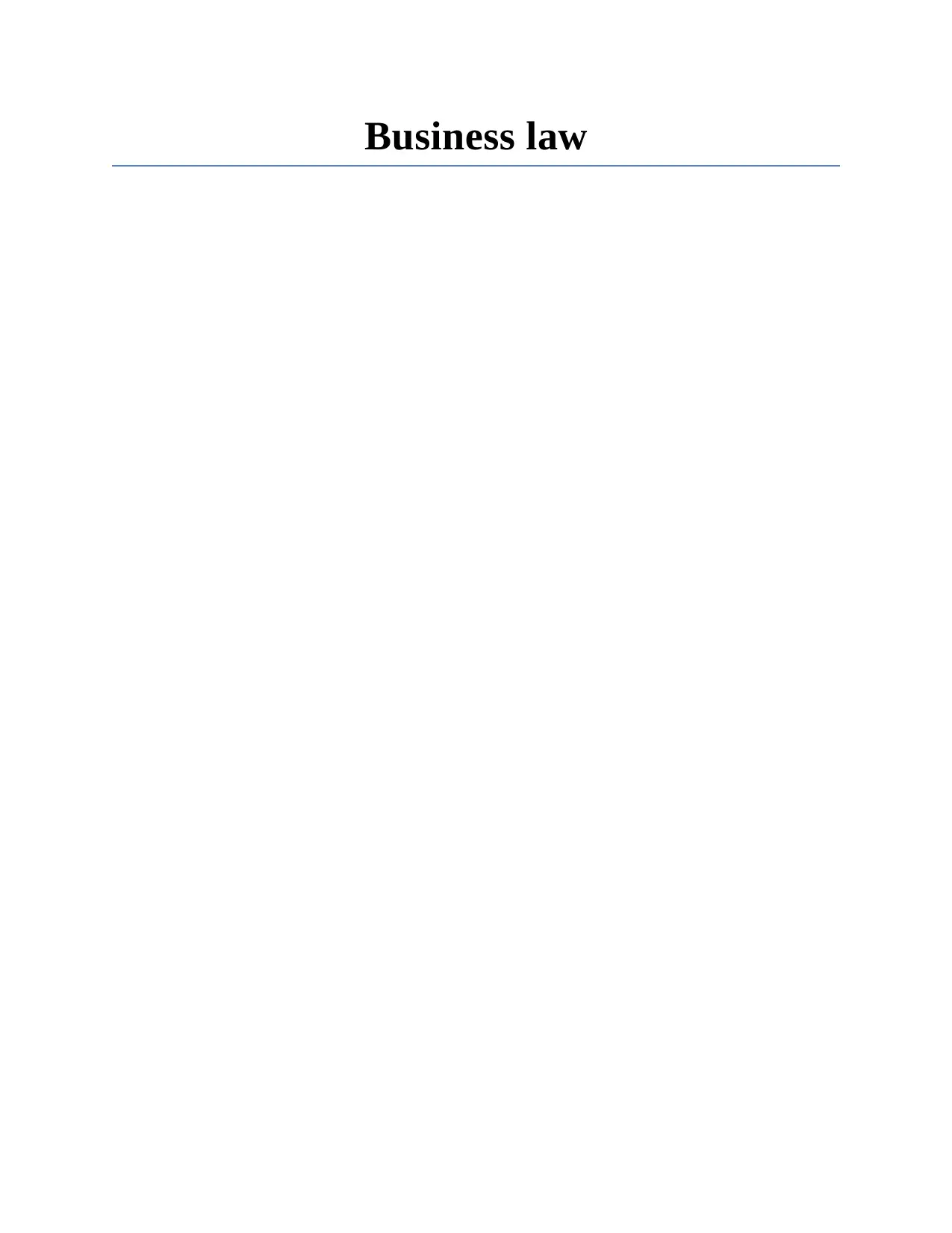
Business law
Paraphrase This Document
Need a fresh take? Get an instant paraphrase of this document with our AI Paraphraser
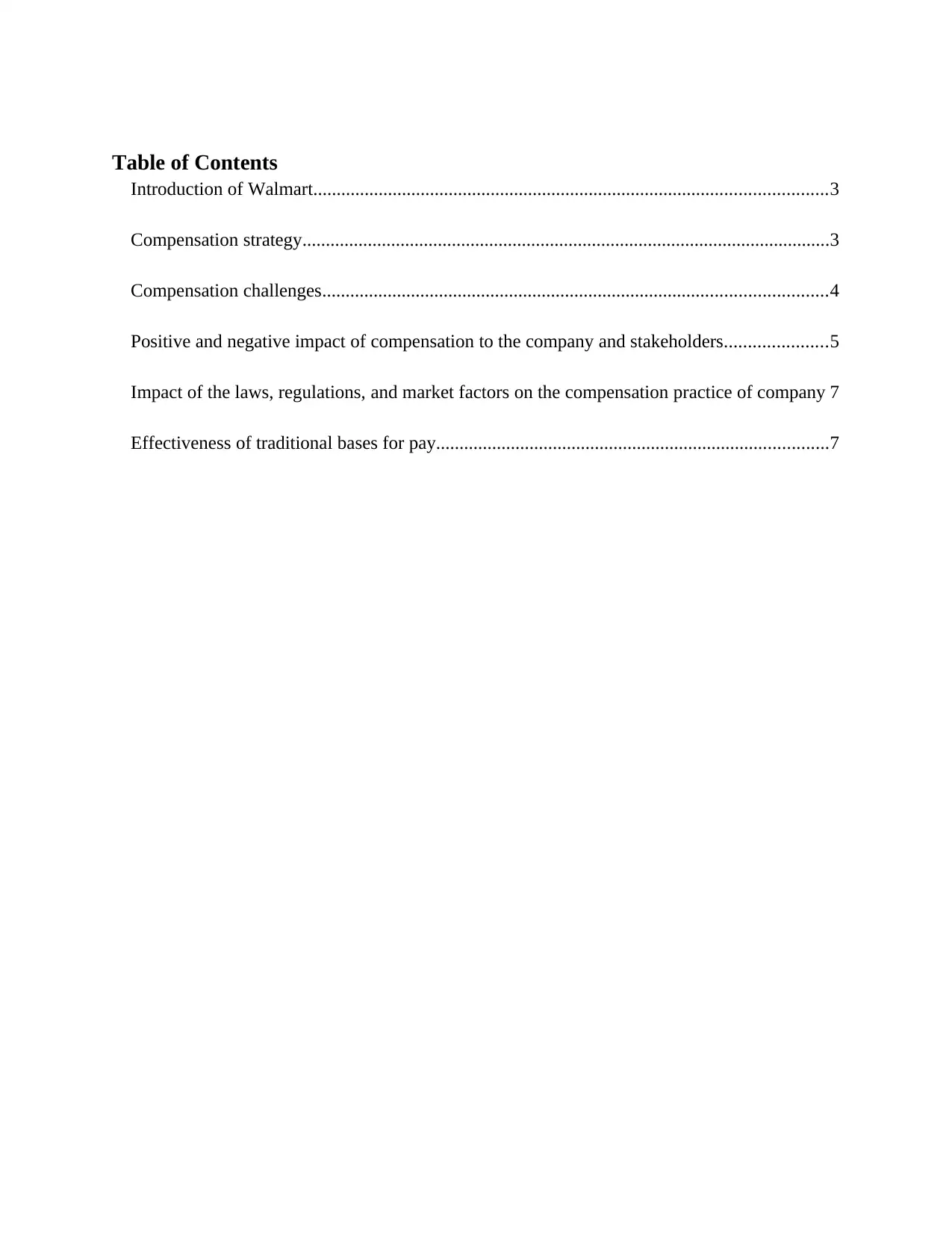
Table of Contents
Introduction of Walmart..............................................................................................................3
Compensation strategy.................................................................................................................3
Compensation challenges............................................................................................................4
Positive and negative impact of compensation to the company and stakeholders......................5
Impact of the laws, regulations, and market factors on the compensation practice of company 7
Effectiveness of traditional bases for pay....................................................................................7
Introduction of Walmart..............................................................................................................3
Compensation strategy.................................................................................................................3
Compensation challenges............................................................................................................4
Positive and negative impact of compensation to the company and stakeholders......................5
Impact of the laws, regulations, and market factors on the compensation practice of company 7
Effectiveness of traditional bases for pay....................................................................................7
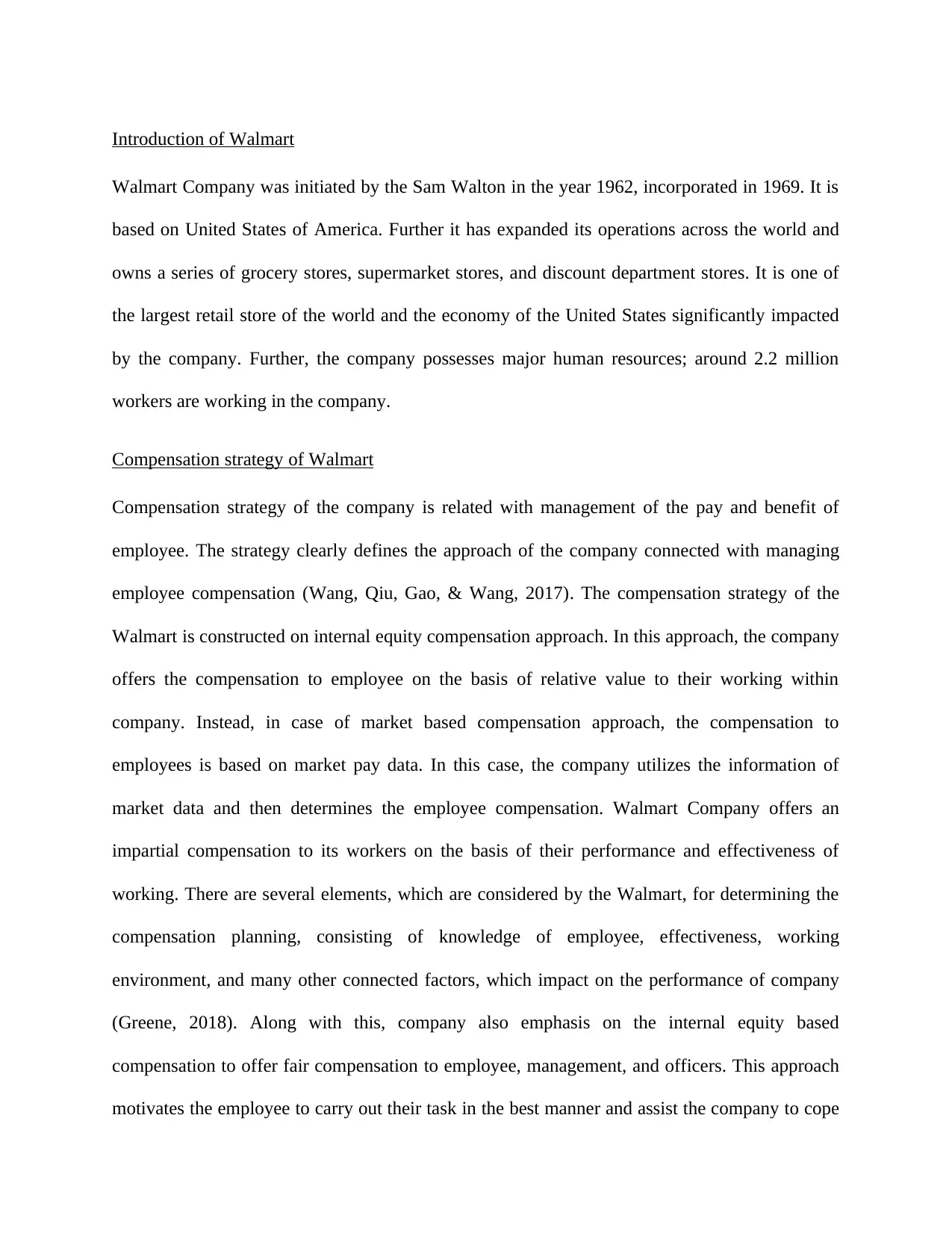
Introduction of Walmart
Walmart Company was initiated by the Sam Walton in the year 1962, incorporated in 1969. It is
based on United States of America. Further it has expanded its operations across the world and
owns a series of grocery stores, supermarket stores, and discount department stores. It is one of
the largest retail store of the world and the economy of the United States significantly impacted
by the company. Further, the company possesses major human resources; around 2.2 million
workers are working in the company.
Compensation strategy of Walmart
Compensation strategy of the company is related with management of the pay and benefit of
employee. The strategy clearly defines the approach of the company connected with managing
employee compensation (Wang, Qiu, Gao, & Wang, 2017). The compensation strategy of the
Walmart is constructed on internal equity compensation approach. In this approach, the company
offers the compensation to employee on the basis of relative value to their working within
company. Instead, in case of market based compensation approach, the compensation to
employees is based on market pay data. In this case, the company utilizes the information of
market data and then determines the employee compensation. Walmart Company offers an
impartial compensation to its workers on the basis of their performance and effectiveness of
working. There are several elements, which are considered by the Walmart, for determining the
compensation planning, consisting of knowledge of employee, effectiveness, working
environment, and many other connected factors, which impact on the performance of company
(Greene, 2018). Along with this, company also emphasis on the internal equity based
compensation to offer fair compensation to employee, management, and officers. This approach
motivates the employee to carry out their task in the best manner and assist the company to cope
Walmart Company was initiated by the Sam Walton in the year 1962, incorporated in 1969. It is
based on United States of America. Further it has expanded its operations across the world and
owns a series of grocery stores, supermarket stores, and discount department stores. It is one of
the largest retail store of the world and the economy of the United States significantly impacted
by the company. Further, the company possesses major human resources; around 2.2 million
workers are working in the company.
Compensation strategy of Walmart
Compensation strategy of the company is related with management of the pay and benefit of
employee. The strategy clearly defines the approach of the company connected with managing
employee compensation (Wang, Qiu, Gao, & Wang, 2017). The compensation strategy of the
Walmart is constructed on internal equity compensation approach. In this approach, the company
offers the compensation to employee on the basis of relative value to their working within
company. Instead, in case of market based compensation approach, the compensation to
employees is based on market pay data. In this case, the company utilizes the information of
market data and then determines the employee compensation. Walmart Company offers an
impartial compensation to its workers on the basis of their performance and effectiveness of
working. There are several elements, which are considered by the Walmart, for determining the
compensation planning, consisting of knowledge of employee, effectiveness, working
environment, and many other connected factors, which impact on the performance of company
(Greene, 2018). Along with this, company also emphasis on the internal equity based
compensation to offer fair compensation to employee, management, and officers. This approach
motivates the employee to carry out their task in the best manner and assist the company to cope
⊘ This is a preview!⊘
Do you want full access?
Subscribe today to unlock all pages.

Trusted by 1+ million students worldwide
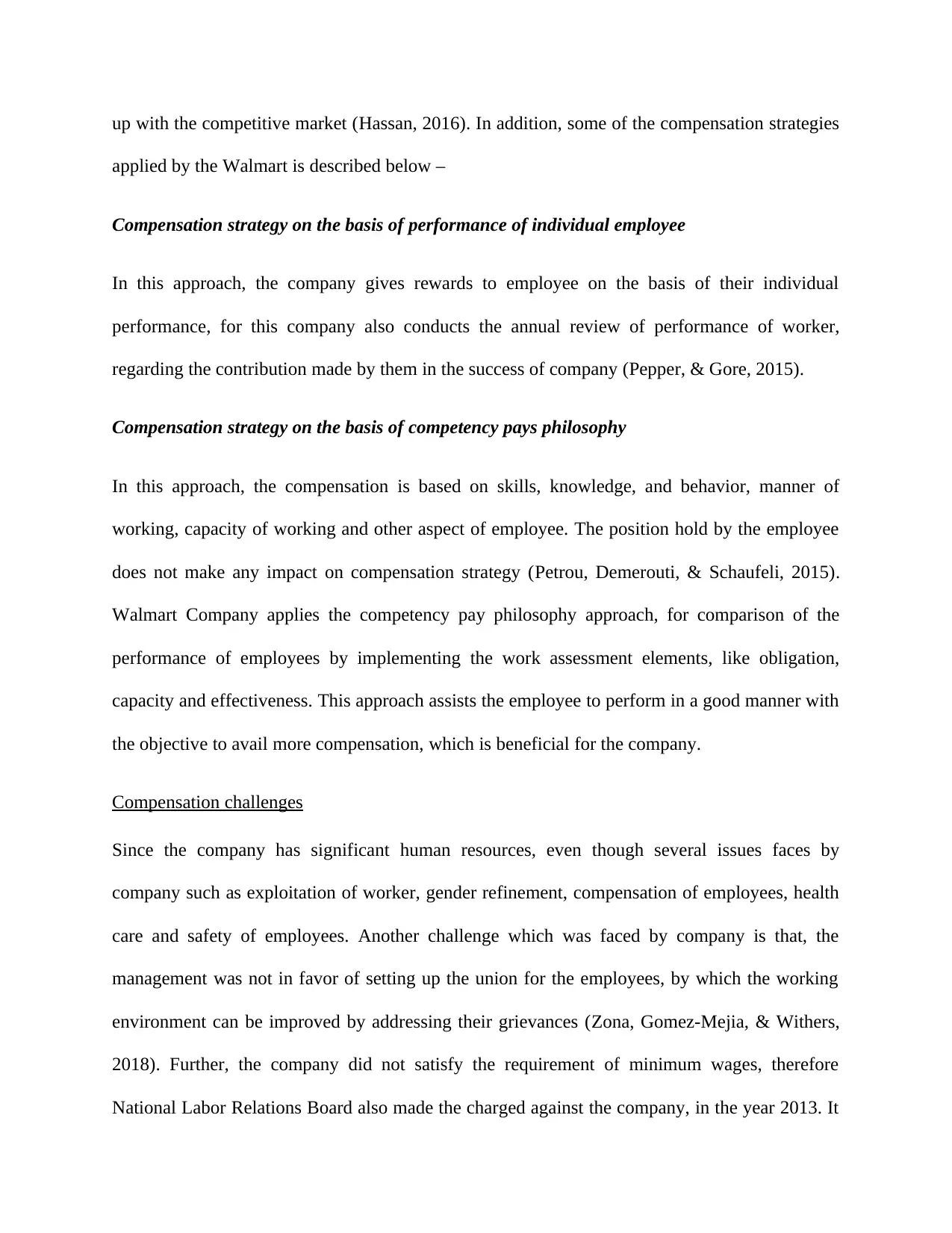
up with the competitive market (Hassan, 2016). In addition, some of the compensation strategies
applied by the Walmart is described below –
Compensation strategy on the basis of performance of individual employee
In this approach, the company gives rewards to employee on the basis of their individual
performance, for this company also conducts the annual review of performance of worker,
regarding the contribution made by them in the success of company (Pepper, & Gore, 2015).
Compensation strategy on the basis of competency pays philosophy
In this approach, the compensation is based on skills, knowledge, and behavior, manner of
working, capacity of working and other aspect of employee. The position hold by the employee
does not make any impact on compensation strategy (Petrou, Demerouti, & Schaufeli, 2015).
Walmart Company applies the competency pay philosophy approach, for comparison of the
performance of employees by implementing the work assessment elements, like obligation,
capacity and effectiveness. This approach assists the employee to perform in a good manner with
the objective to avail more compensation, which is beneficial for the company.
Compensation challenges
Since the company has significant human resources, even though several issues faces by
company such as exploitation of worker, gender refinement, compensation of employees, health
care and safety of employees. Another challenge which was faced by company is that, the
management was not in favor of setting up the union for the employees, by which the working
environment can be improved by addressing their grievances (Zona, Gomez-Mejia, & Withers,
2018). Further, the company did not satisfy the requirement of minimum wages, therefore
National Labor Relations Board also made the charged against the company, in the year 2013. It
applied by the Walmart is described below –
Compensation strategy on the basis of performance of individual employee
In this approach, the company gives rewards to employee on the basis of their individual
performance, for this company also conducts the annual review of performance of worker,
regarding the contribution made by them in the success of company (Pepper, & Gore, 2015).
Compensation strategy on the basis of competency pays philosophy
In this approach, the compensation is based on skills, knowledge, and behavior, manner of
working, capacity of working and other aspect of employee. The position hold by the employee
does not make any impact on compensation strategy (Petrou, Demerouti, & Schaufeli, 2015).
Walmart Company applies the competency pay philosophy approach, for comparison of the
performance of employees by implementing the work assessment elements, like obligation,
capacity and effectiveness. This approach assists the employee to perform in a good manner with
the objective to avail more compensation, which is beneficial for the company.
Compensation challenges
Since the company has significant human resources, even though several issues faces by
company such as exploitation of worker, gender refinement, compensation of employees, health
care and safety of employees. Another challenge which was faced by company is that, the
management was not in favor of setting up the union for the employees, by which the working
environment can be improved by addressing their grievances (Zona, Gomez-Mejia, & Withers,
2018). Further, the company did not satisfy the requirement of minimum wages, therefore
National Labor Relations Board also made the charged against the company, in the year 2013. It
Paraphrase This Document
Need a fresh take? Get an instant paraphrase of this document with our AI Paraphraser
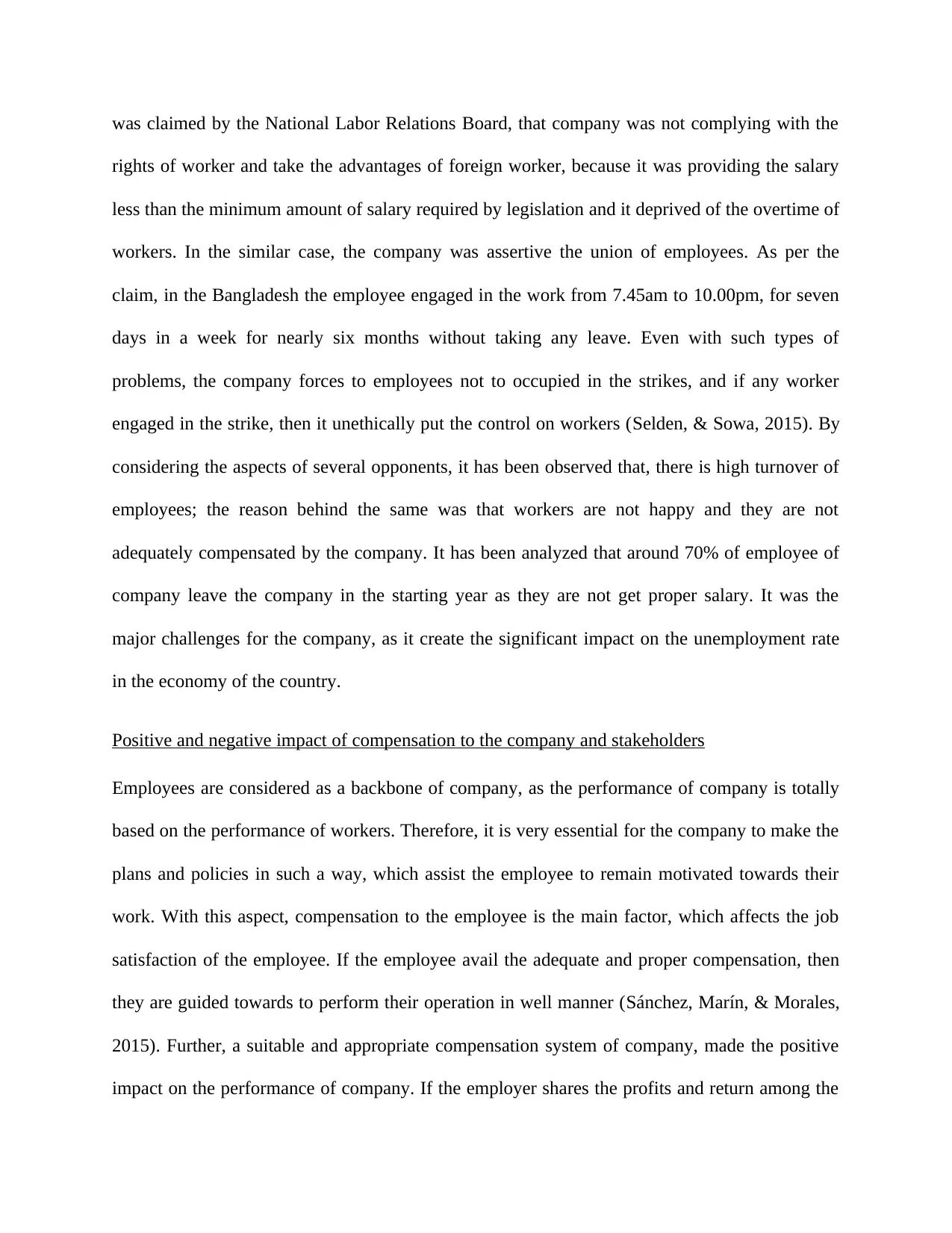
was claimed by the National Labor Relations Board, that company was not complying with the
rights of worker and take the advantages of foreign worker, because it was providing the salary
less than the minimum amount of salary required by legislation and it deprived of the overtime of
workers. In the similar case, the company was assertive the union of employees. As per the
claim, in the Bangladesh the employee engaged in the work from 7.45am to 10.00pm, for seven
days in a week for nearly six months without taking any leave. Even with such types of
problems, the company forces to employees not to occupied in the strikes, and if any worker
engaged in the strike, then it unethically put the control on workers (Selden, & Sowa, 2015). By
considering the aspects of several opponents, it has been observed that, there is high turnover of
employees; the reason behind the same was that workers are not happy and they are not
adequately compensated by the company. It has been analyzed that around 70% of employee of
company leave the company in the starting year as they are not get proper salary. It was the
major challenges for the company, as it create the significant impact on the unemployment rate
in the economy of the country.
Positive and negative impact of compensation to the company and stakeholders
Employees are considered as a backbone of company, as the performance of company is totally
based on the performance of workers. Therefore, it is very essential for the company to make the
plans and policies in such a way, which assist the employee to remain motivated towards their
work. With this aspect, compensation to the employee is the main factor, which affects the job
satisfaction of the employee. If the employee avail the adequate and proper compensation, then
they are guided towards to perform their operation in well manner (Sánchez, Marín, & Morales,
2015). Further, a suitable and appropriate compensation system of company, made the positive
impact on the performance of company. If the employer shares the profits and return among the
rights of worker and take the advantages of foreign worker, because it was providing the salary
less than the minimum amount of salary required by legislation and it deprived of the overtime of
workers. In the similar case, the company was assertive the union of employees. As per the
claim, in the Bangladesh the employee engaged in the work from 7.45am to 10.00pm, for seven
days in a week for nearly six months without taking any leave. Even with such types of
problems, the company forces to employees not to occupied in the strikes, and if any worker
engaged in the strike, then it unethically put the control on workers (Selden, & Sowa, 2015). By
considering the aspects of several opponents, it has been observed that, there is high turnover of
employees; the reason behind the same was that workers are not happy and they are not
adequately compensated by the company. It has been analyzed that around 70% of employee of
company leave the company in the starting year as they are not get proper salary. It was the
major challenges for the company, as it create the significant impact on the unemployment rate
in the economy of the country.
Positive and negative impact of compensation to the company and stakeholders
Employees are considered as a backbone of company, as the performance of company is totally
based on the performance of workers. Therefore, it is very essential for the company to make the
plans and policies in such a way, which assist the employee to remain motivated towards their
work. With this aspect, compensation to the employee is the main factor, which affects the job
satisfaction of the employee. If the employee avail the adequate and proper compensation, then
they are guided towards to perform their operation in well manner (Sánchez, Marín, & Morales,
2015). Further, a suitable and appropriate compensation system of company, made the positive
impact on the performance of company. If the employer shares the profits and return among the
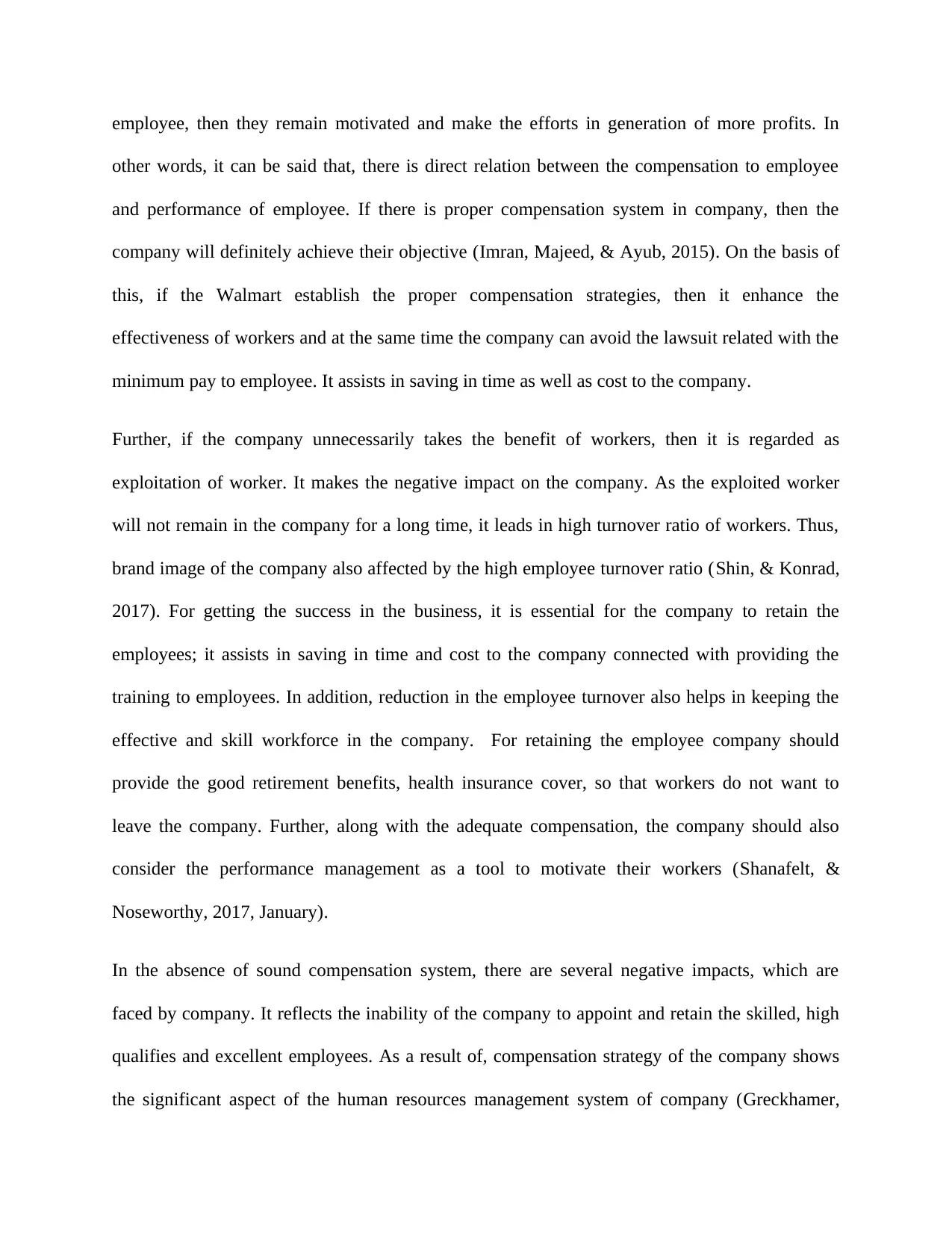
employee, then they remain motivated and make the efforts in generation of more profits. In
other words, it can be said that, there is direct relation between the compensation to employee
and performance of employee. If there is proper compensation system in company, then the
company will definitely achieve their objective (Imran, Majeed, & Ayub, 2015). On the basis of
this, if the Walmart establish the proper compensation strategies, then it enhance the
effectiveness of workers and at the same time the company can avoid the lawsuit related with the
minimum pay to employee. It assists in saving in time as well as cost to the company.
Further, if the company unnecessarily takes the benefit of workers, then it is regarded as
exploitation of worker. It makes the negative impact on the company. As the exploited worker
will not remain in the company for a long time, it leads in high turnover ratio of workers. Thus,
brand image of the company also affected by the high employee turnover ratio (Shin, & Konrad,
2017). For getting the success in the business, it is essential for the company to retain the
employees; it assists in saving in time and cost to the company connected with providing the
training to employees. In addition, reduction in the employee turnover also helps in keeping the
effective and skill workforce in the company. For retaining the employee company should
provide the good retirement benefits, health insurance cover, so that workers do not want to
leave the company. Further, along with the adequate compensation, the company should also
consider the performance management as a tool to motivate their workers (Shanafelt, &
Noseworthy, 2017, January).
In the absence of sound compensation system, there are several negative impacts, which are
faced by company. It reflects the inability of the company to appoint and retain the skilled, high
qualifies and excellent employees. As a result of, compensation strategy of the company shows
the significant aspect of the human resources management system of company (Greckhamer,
other words, it can be said that, there is direct relation between the compensation to employee
and performance of employee. If there is proper compensation system in company, then the
company will definitely achieve their objective (Imran, Majeed, & Ayub, 2015). On the basis of
this, if the Walmart establish the proper compensation strategies, then it enhance the
effectiveness of workers and at the same time the company can avoid the lawsuit related with the
minimum pay to employee. It assists in saving in time as well as cost to the company.
Further, if the company unnecessarily takes the benefit of workers, then it is regarded as
exploitation of worker. It makes the negative impact on the company. As the exploited worker
will not remain in the company for a long time, it leads in high turnover ratio of workers. Thus,
brand image of the company also affected by the high employee turnover ratio (Shin, & Konrad,
2017). For getting the success in the business, it is essential for the company to retain the
employees; it assists in saving in time and cost to the company connected with providing the
training to employees. In addition, reduction in the employee turnover also helps in keeping the
effective and skill workforce in the company. For retaining the employee company should
provide the good retirement benefits, health insurance cover, so that workers do not want to
leave the company. Further, along with the adequate compensation, the company should also
consider the performance management as a tool to motivate their workers (Shanafelt, &
Noseworthy, 2017, January).
In the absence of sound compensation system, there are several negative impacts, which are
faced by company. It reflects the inability of the company to appoint and retain the skilled, high
qualifies and excellent employees. As a result of, compensation strategy of the company shows
the significant aspect of the human resources management system of company (Greckhamer,
⊘ This is a preview!⊘
Do you want full access?
Subscribe today to unlock all pages.

Trusted by 1+ million students worldwide
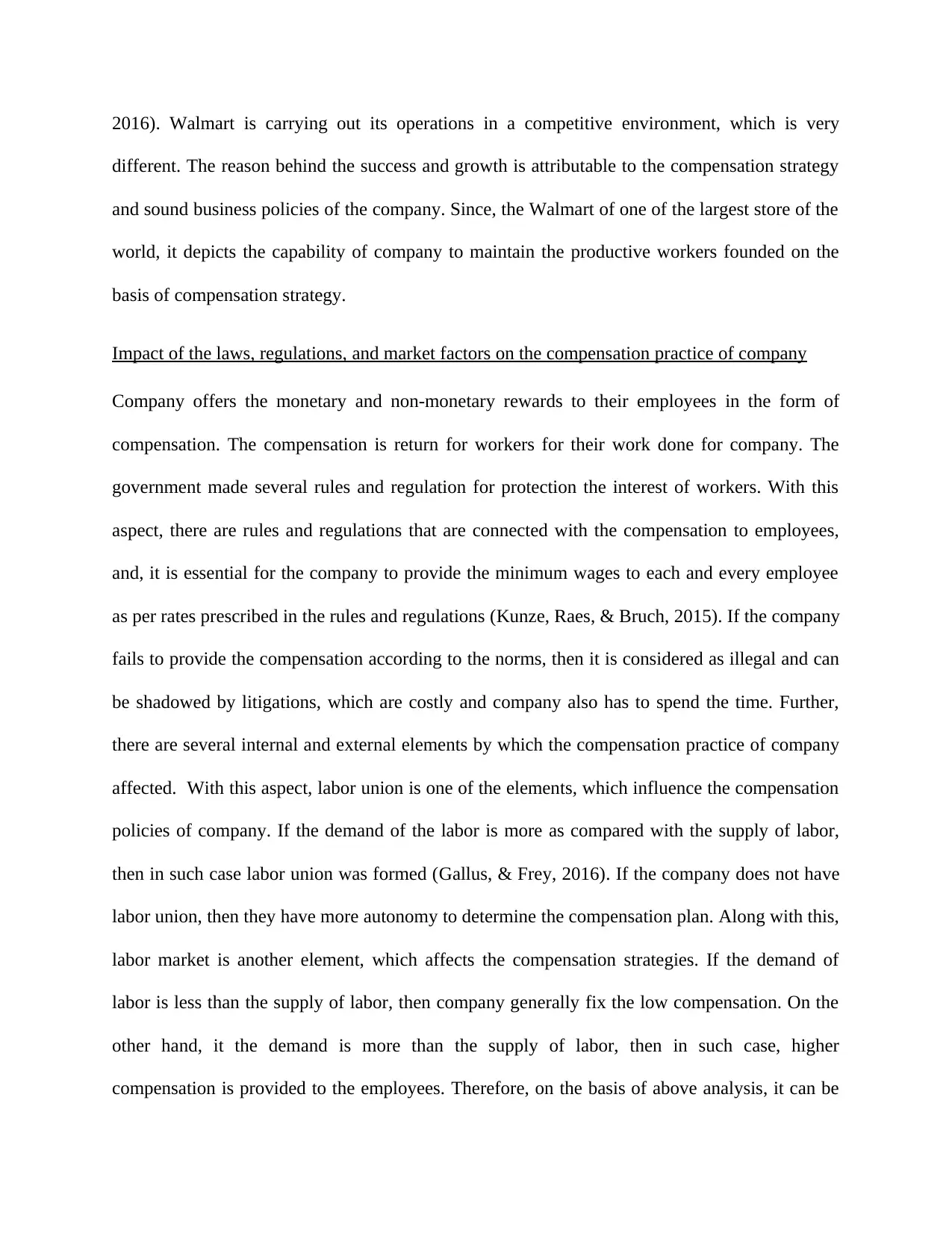
2016). Walmart is carrying out its operations in a competitive environment, which is very
different. The reason behind the success and growth is attributable to the compensation strategy
and sound business policies of the company. Since, the Walmart of one of the largest store of the
world, it depicts the capability of company to maintain the productive workers founded on the
basis of compensation strategy.
Impact of the laws, regulations, and market factors on the compensation practice of company
Company offers the monetary and non-monetary rewards to their employees in the form of
compensation. The compensation is return for workers for their work done for company. The
government made several rules and regulation for protection the interest of workers. With this
aspect, there are rules and regulations that are connected with the compensation to employees,
and, it is essential for the company to provide the minimum wages to each and every employee
as per rates prescribed in the rules and regulations (Kunze, Raes, & Bruch, 2015). If the company
fails to provide the compensation according to the norms, then it is considered as illegal and can
be shadowed by litigations, which are costly and company also has to spend the time. Further,
there are several internal and external elements by which the compensation practice of company
affected. With this aspect, labor union is one of the elements, which influence the compensation
policies of company. If the demand of the labor is more as compared with the supply of labor,
then in such case labor union was formed (Gallus, & Frey, 2016). If the company does not have
labor union, then they have more autonomy to determine the compensation plan. Along with this,
labor market is another element, which affects the compensation strategies. If the demand of
labor is less than the supply of labor, then company generally fix the low compensation. On the
other hand, it the demand is more than the supply of labor, then in such case, higher
compensation is provided to the employees. Therefore, on the basis of above analysis, it can be
different. The reason behind the success and growth is attributable to the compensation strategy
and sound business policies of the company. Since, the Walmart of one of the largest store of the
world, it depicts the capability of company to maintain the productive workers founded on the
basis of compensation strategy.
Impact of the laws, regulations, and market factors on the compensation practice of company
Company offers the monetary and non-monetary rewards to their employees in the form of
compensation. The compensation is return for workers for their work done for company. The
government made several rules and regulation for protection the interest of workers. With this
aspect, there are rules and regulations that are connected with the compensation to employees,
and, it is essential for the company to provide the minimum wages to each and every employee
as per rates prescribed in the rules and regulations (Kunze, Raes, & Bruch, 2015). If the company
fails to provide the compensation according to the norms, then it is considered as illegal and can
be shadowed by litigations, which are costly and company also has to spend the time. Further,
there are several internal and external elements by which the compensation practice of company
affected. With this aspect, labor union is one of the elements, which influence the compensation
policies of company. If the demand of the labor is more as compared with the supply of labor,
then in such case labor union was formed (Gallus, & Frey, 2016). If the company does not have
labor union, then they have more autonomy to determine the compensation plan. Along with this,
labor market is another element, which affects the compensation strategies. If the demand of
labor is less than the supply of labor, then company generally fix the low compensation. On the
other hand, it the demand is more than the supply of labor, then in such case, higher
compensation is provided to the employees. Therefore, on the basis of above analysis, it can be
Paraphrase This Document
Need a fresh take? Get an instant paraphrase of this document with our AI Paraphraser
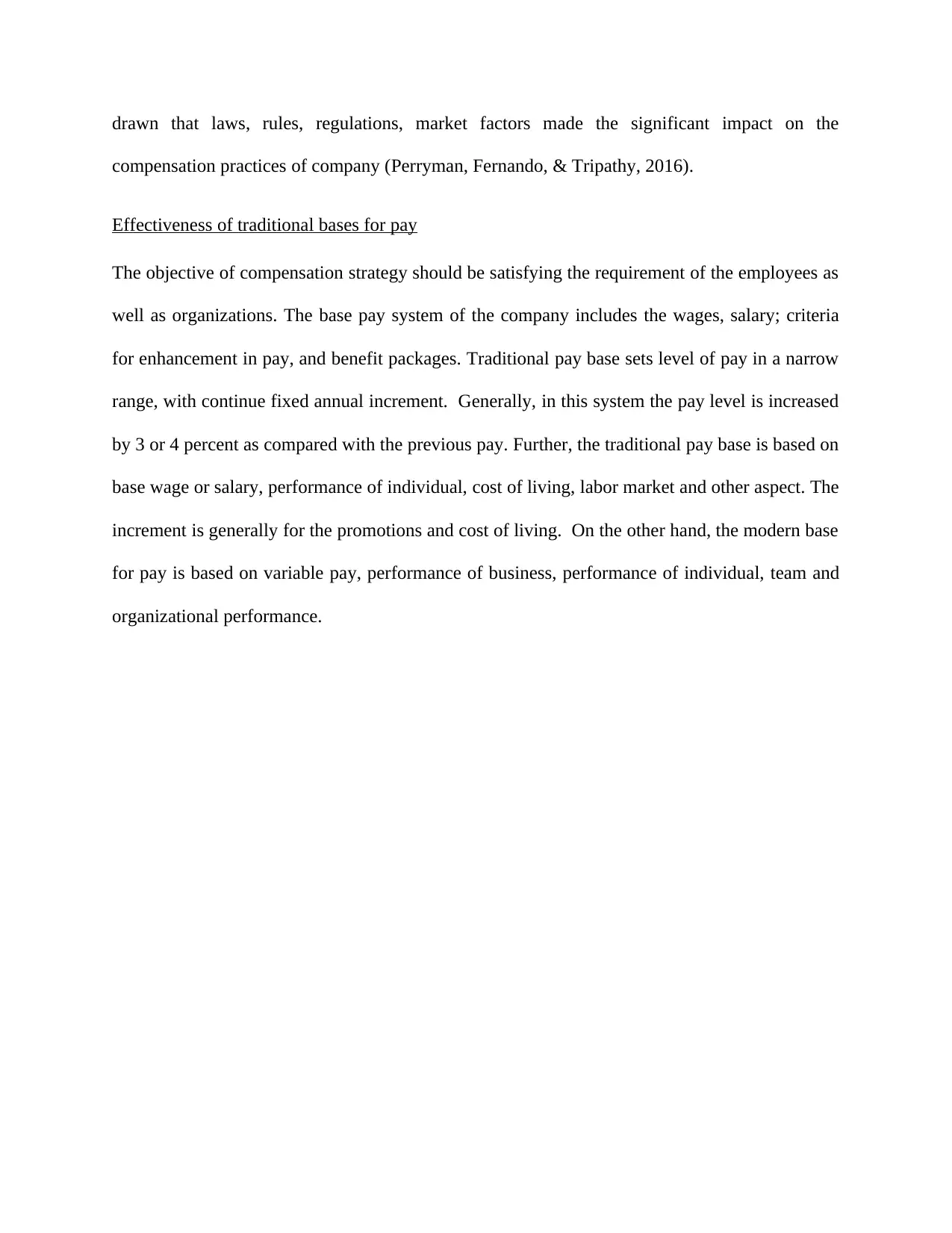
drawn that laws, rules, regulations, market factors made the significant impact on the
compensation practices of company (Perryman, Fernando, & Tripathy, 2016).
Effectiveness of traditional bases for pay
The objective of compensation strategy should be satisfying the requirement of the employees as
well as organizations. The base pay system of the company includes the wages, salary; criteria
for enhancement in pay, and benefit packages. Traditional pay base sets level of pay in a narrow
range, with continue fixed annual increment. Generally, in this system the pay level is increased
by 3 or 4 percent as compared with the previous pay. Further, the traditional pay base is based on
base wage or salary, performance of individual, cost of living, labor market and other aspect. The
increment is generally for the promotions and cost of living. On the other hand, the modern base
for pay is based on variable pay, performance of business, performance of individual, team and
organizational performance.
compensation practices of company (Perryman, Fernando, & Tripathy, 2016).
Effectiveness of traditional bases for pay
The objective of compensation strategy should be satisfying the requirement of the employees as
well as organizations. The base pay system of the company includes the wages, salary; criteria
for enhancement in pay, and benefit packages. Traditional pay base sets level of pay in a narrow
range, with continue fixed annual increment. Generally, in this system the pay level is increased
by 3 or 4 percent as compared with the previous pay. Further, the traditional pay base is based on
base wage or salary, performance of individual, cost of living, labor market and other aspect. The
increment is generally for the promotions and cost of living. On the other hand, the modern base
for pay is based on variable pay, performance of business, performance of individual, team and
organizational performance.
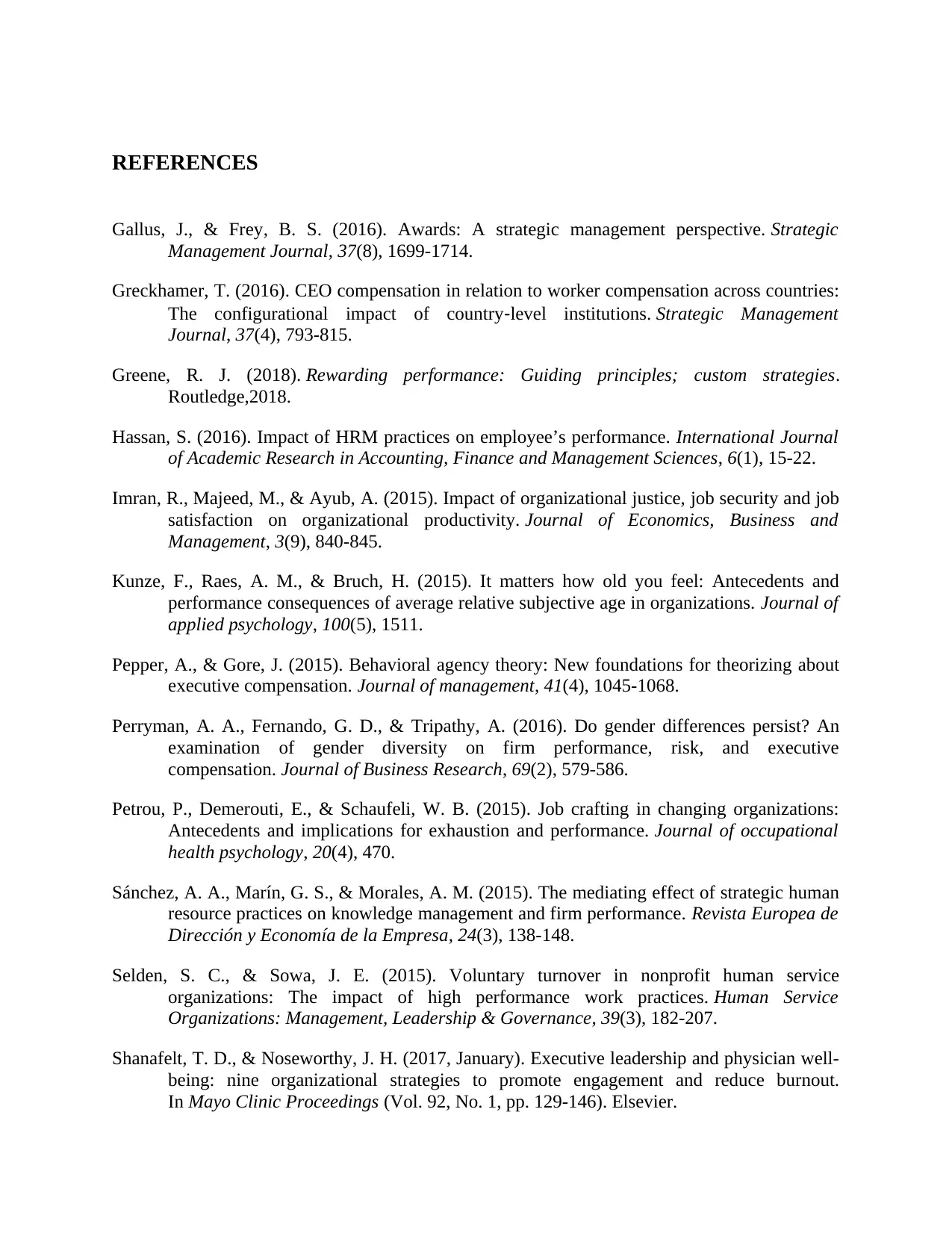
REFERENCES
Gallus, J., & Frey, B. S. (2016). Awards: A strategic management perspective. Strategic
Management Journal, 37(8), 1699-1714.
Greckhamer, T. (2016). CEO compensation in relation to worker compensation across countries:
The configurational impact of country‐level institutions. Strategic Management
Journal, 37(4), 793-815.
Greene, R. J. (2018). Rewarding performance: Guiding principles; custom strategies.
Routledge,2018.
Hassan, S. (2016). Impact of HRM practices on employee’s performance. International Journal
of Academic Research in Accounting, Finance and Management Sciences, 6(1), 15-22.
Imran, R., Majeed, M., & Ayub, A. (2015). Impact of organizational justice, job security and job
satisfaction on organizational productivity. Journal of Economics, Business and
Management, 3(9), 840-845.
Kunze, F., Raes, A. M., & Bruch, H. (2015). It matters how old you feel: Antecedents and
performance consequences of average relative subjective age in organizations. Journal of
applied psychology, 100(5), 1511.
Pepper, A., & Gore, J. (2015). Behavioral agency theory: New foundations for theorizing about
executive compensation. Journal of management, 41(4), 1045-1068.
Perryman, A. A., Fernando, G. D., & Tripathy, A. (2016). Do gender differences persist? An
examination of gender diversity on firm performance, risk, and executive
compensation. Journal of Business Research, 69(2), 579-586.
Petrou, P., Demerouti, E., & Schaufeli, W. B. (2015). Job crafting in changing organizations:
Antecedents and implications for exhaustion and performance. Journal of occupational
health psychology, 20(4), 470.
Sánchez, A. A., Marín, G. S., & Morales, A. M. (2015). The mediating effect of strategic human
resource practices on knowledge management and firm performance. Revista Europea de
Dirección y Economía de la Empresa, 24(3), 138-148.
Selden, S. C., & Sowa, J. E. (2015). Voluntary turnover in nonprofit human service
organizations: The impact of high performance work practices. Human Service
Organizations: Management, Leadership & Governance, 39(3), 182-207.
Shanafelt, T. D., & Noseworthy, J. H. (2017, January). Executive leadership and physician well-
being: nine organizational strategies to promote engagement and reduce burnout.
In Mayo Clinic Proceedings (Vol. 92, No. 1, pp. 129-146). Elsevier.
Gallus, J., & Frey, B. S. (2016). Awards: A strategic management perspective. Strategic
Management Journal, 37(8), 1699-1714.
Greckhamer, T. (2016). CEO compensation in relation to worker compensation across countries:
The configurational impact of country‐level institutions. Strategic Management
Journal, 37(4), 793-815.
Greene, R. J. (2018). Rewarding performance: Guiding principles; custom strategies.
Routledge,2018.
Hassan, S. (2016). Impact of HRM practices on employee’s performance. International Journal
of Academic Research in Accounting, Finance and Management Sciences, 6(1), 15-22.
Imran, R., Majeed, M., & Ayub, A. (2015). Impact of organizational justice, job security and job
satisfaction on organizational productivity. Journal of Economics, Business and
Management, 3(9), 840-845.
Kunze, F., Raes, A. M., & Bruch, H. (2015). It matters how old you feel: Antecedents and
performance consequences of average relative subjective age in organizations. Journal of
applied psychology, 100(5), 1511.
Pepper, A., & Gore, J. (2015). Behavioral agency theory: New foundations for theorizing about
executive compensation. Journal of management, 41(4), 1045-1068.
Perryman, A. A., Fernando, G. D., & Tripathy, A. (2016). Do gender differences persist? An
examination of gender diversity on firm performance, risk, and executive
compensation. Journal of Business Research, 69(2), 579-586.
Petrou, P., Demerouti, E., & Schaufeli, W. B. (2015). Job crafting in changing organizations:
Antecedents and implications for exhaustion and performance. Journal of occupational
health psychology, 20(4), 470.
Sánchez, A. A., Marín, G. S., & Morales, A. M. (2015). The mediating effect of strategic human
resource practices on knowledge management and firm performance. Revista Europea de
Dirección y Economía de la Empresa, 24(3), 138-148.
Selden, S. C., & Sowa, J. E. (2015). Voluntary turnover in nonprofit human service
organizations: The impact of high performance work practices. Human Service
Organizations: Management, Leadership & Governance, 39(3), 182-207.
Shanafelt, T. D., & Noseworthy, J. H. (2017, January). Executive leadership and physician well-
being: nine organizational strategies to promote engagement and reduce burnout.
In Mayo Clinic Proceedings (Vol. 92, No. 1, pp. 129-146). Elsevier.
⊘ This is a preview!⊘
Do you want full access?
Subscribe today to unlock all pages.

Trusted by 1+ million students worldwide
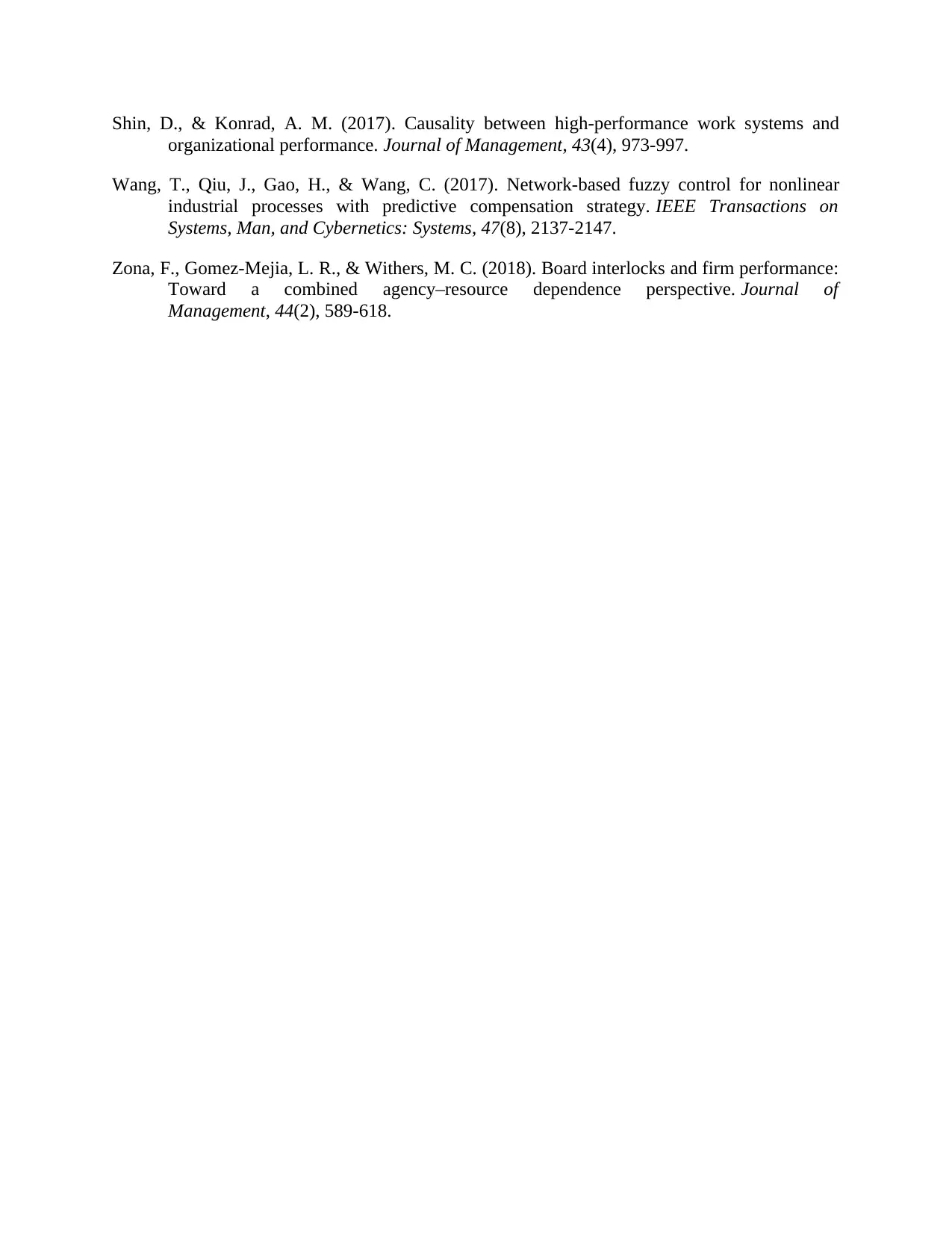
Shin, D., & Konrad, A. M. (2017). Causality between high-performance work systems and
organizational performance. Journal of Management, 43(4), 973-997.
Wang, T., Qiu, J., Gao, H., & Wang, C. (2017). Network-based fuzzy control for nonlinear
industrial processes with predictive compensation strategy. IEEE Transactions on
Systems, Man, and Cybernetics: Systems, 47(8), 2137-2147.
Zona, F., Gomez-Mejia, L. R., & Withers, M. C. (2018). Board interlocks and firm performance:
Toward a combined agency–resource dependence perspective. Journal of
Management, 44(2), 589-618.
organizational performance. Journal of Management, 43(4), 973-997.
Wang, T., Qiu, J., Gao, H., & Wang, C. (2017). Network-based fuzzy control for nonlinear
industrial processes with predictive compensation strategy. IEEE Transactions on
Systems, Man, and Cybernetics: Systems, 47(8), 2137-2147.
Zona, F., Gomez-Mejia, L. R., & Withers, M. C. (2018). Board interlocks and firm performance:
Toward a combined agency–resource dependence perspective. Journal of
Management, 44(2), 589-618.
1 out of 10
Related Documents
Your All-in-One AI-Powered Toolkit for Academic Success.
+13062052269
info@desklib.com
Available 24*7 on WhatsApp / Email
![[object Object]](/_next/static/media/star-bottom.7253800d.svg)
Unlock your academic potential
Copyright © 2020–2025 A2Z Services. All Rights Reserved. Developed and managed by ZUCOL.





